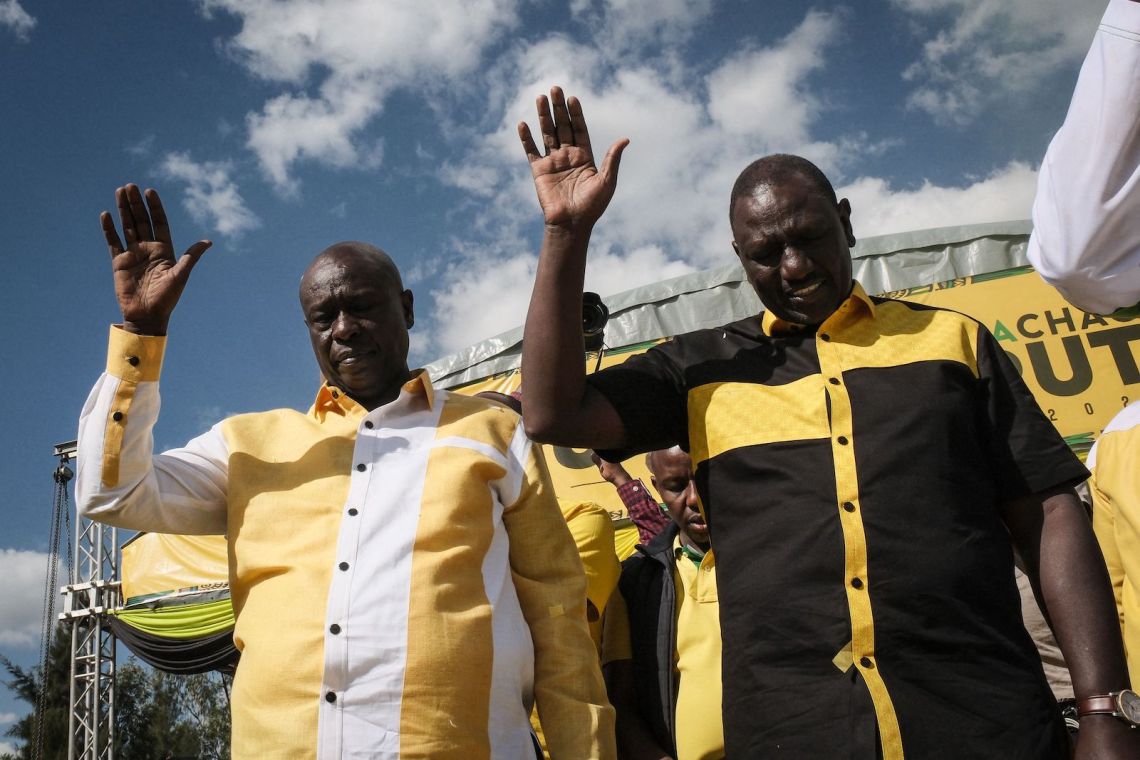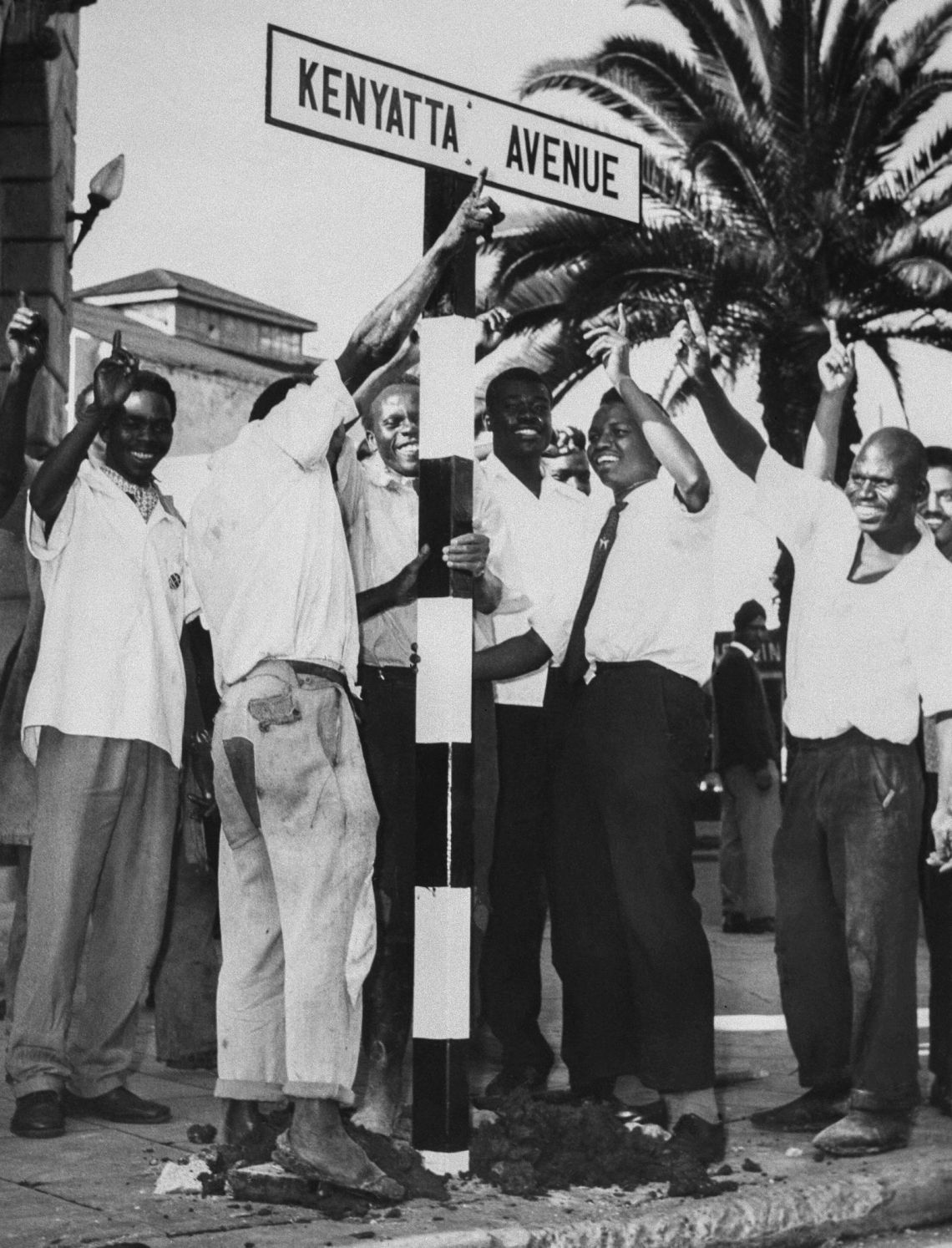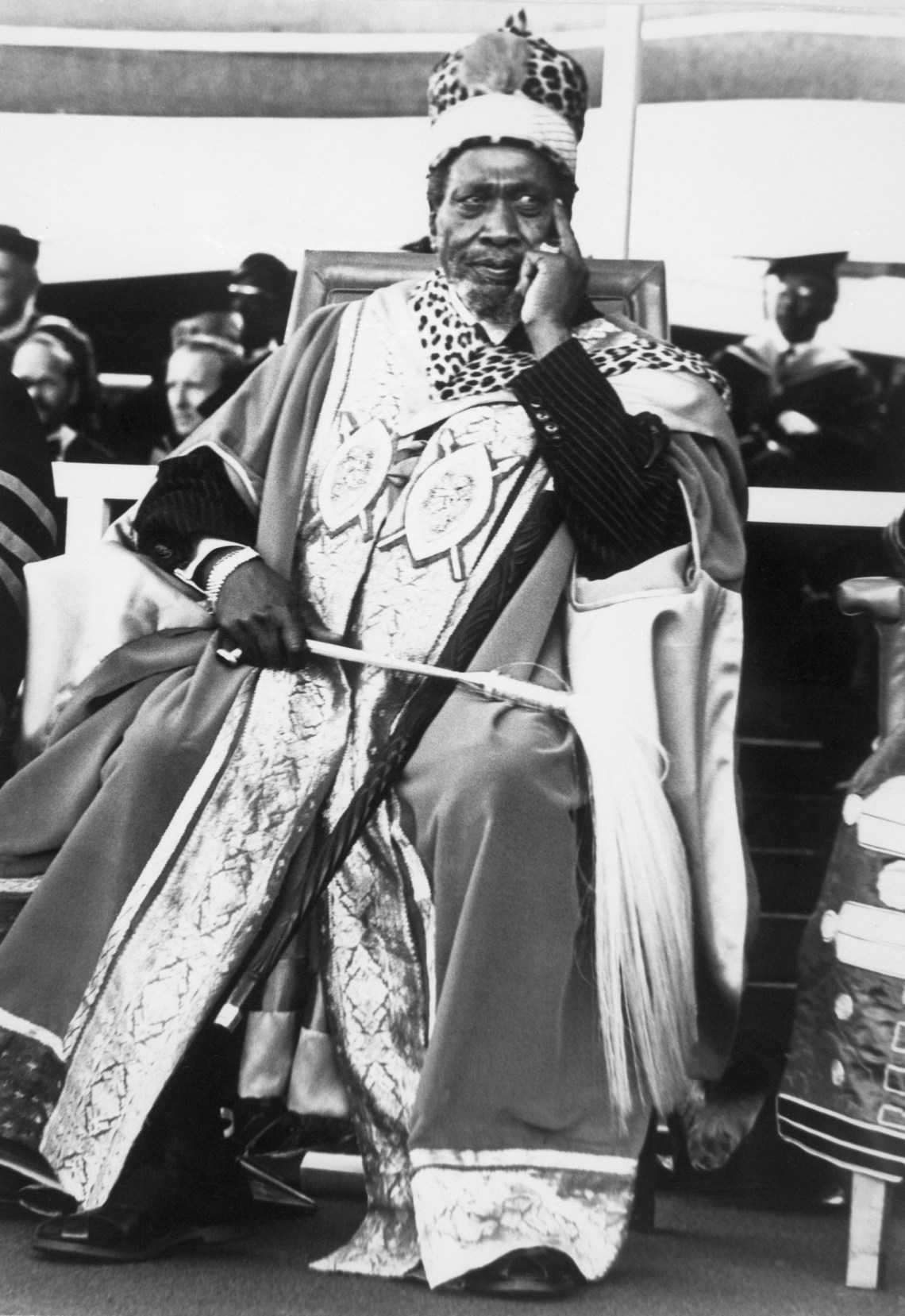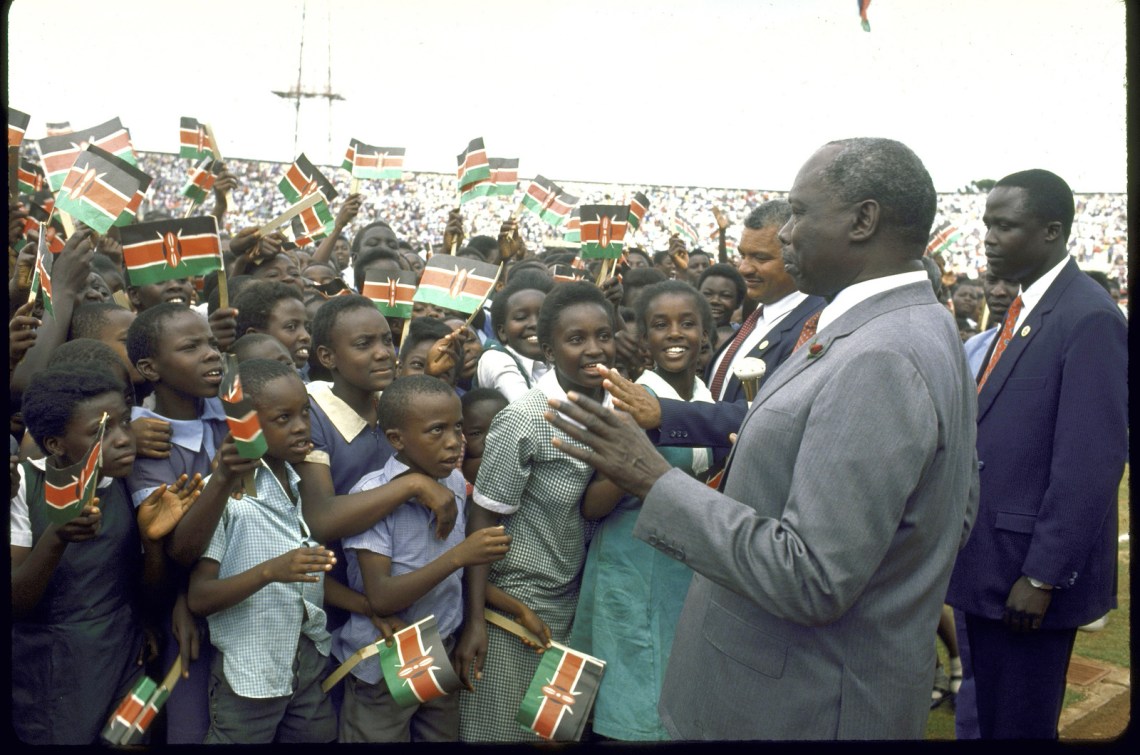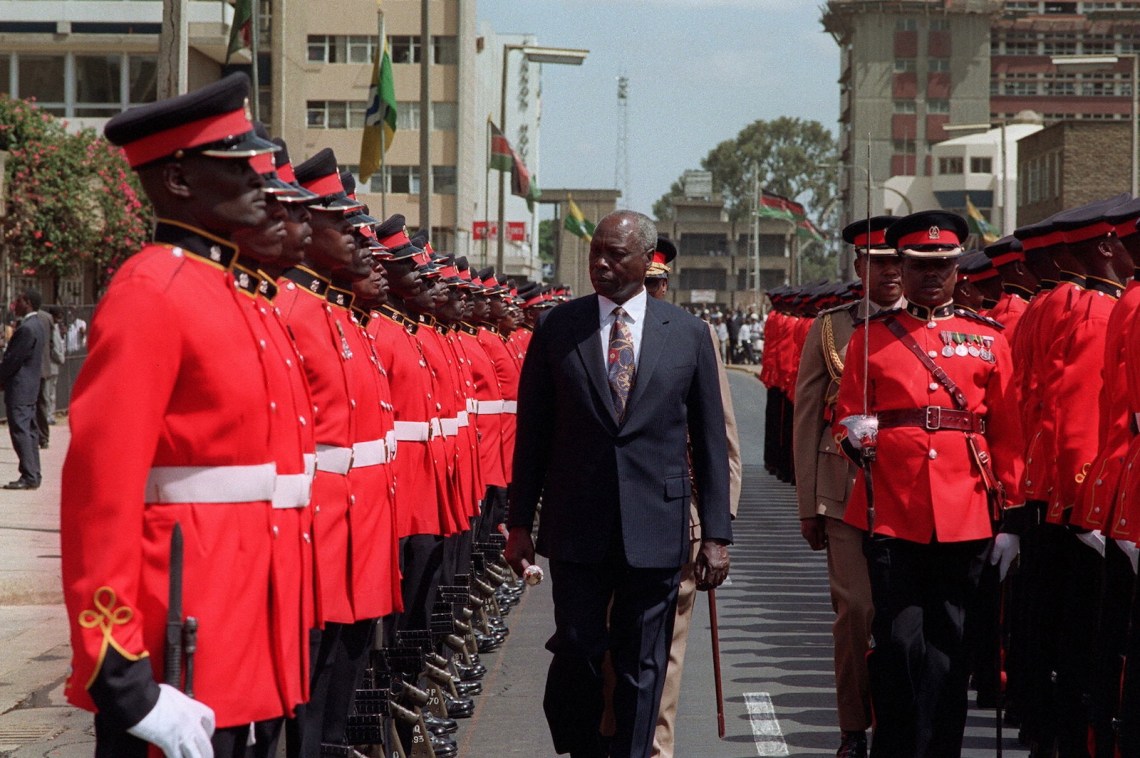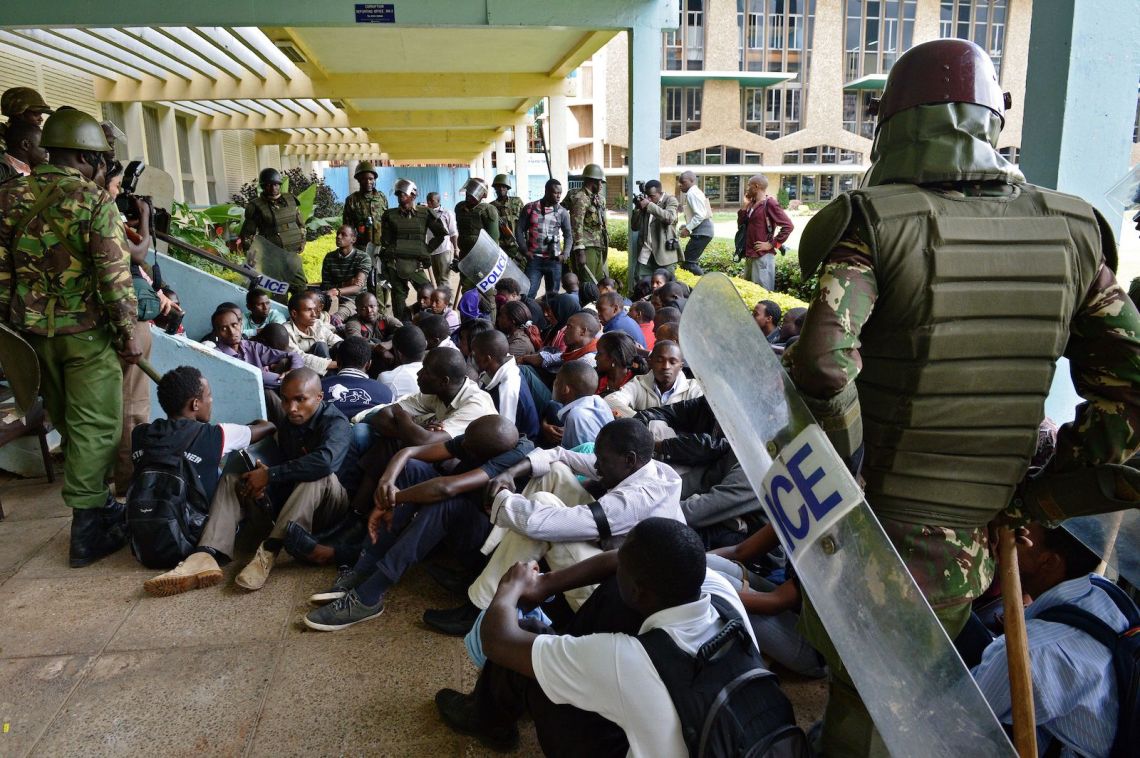The markers “right-wing” and “left-wing” have come to mean almost nothing in Kenya. Over the past twenty years politicians have changed sides, coalitions have been constructed and dismantled, and allegiances have shifted based on vague notions of tribal unity and attempts to beat charges at the International Criminal Court. And yet the 2022 elections proved that some long-standing political alignments have survived. President William Ruto and his deputy Rigathi Gachagua are both former youth members of the party that ruled Kenya for its first four decades as an independent country. By choosing to run together, they were reviving allegiances they had forged in the 1980s as students at the University of Nairobi (UoN), where they were acolytes of Kenya’s second president, Daniel arap Moi.
Moi and his predecessor, Jomo Kenyatta, both belonged to the Kenya African National Union (KANU), the political party formed in 1944 that unified leftist and conservative politicians in the fight for independence from the British Crown. After the country won its independence in 1963, these two sides suffered a rift. Land was a major fault line. Leftist politicians—such as Bildad Kaggia, who had been imprisoned with Kenyatta by the British; Kenyatta’s vice president, Oginga Odinga; and Pio Gama Pinto, the founder and editor of KANU’s newspaper—believed it should be used to resettle Kenyans who had been dispossessed by British settlers, as part of what they considered the new government’s responsibility to lift people out of poverty through direct economic intervention. The government itself, led by Kenyatta and representing the dominant, conservative wing of KANU, instead instituted a mixed market economy and insisted that land pass from willing buyers to willing sellers. Politicians exploited this policy to corruptly acquire land for themselves.
Soon the two sides came into open conflict. Pinto was assassinated, likely on the government’s orders, and the left-leaning politicians quit KANU, a walkout that was also a response to Kenyatta’s courtship of the West. When Odinga resigned as vice president, he was replaced first by Joseph Murumbi—who lasted a matter of months before resigning due to Pinto’s murder and Kenyatta’s growing authoritarianism—and then by Moi, who became president when Kenyatta died twelve years later.
Moi belonged to the club of African “big men,” totalitarian rulers who fostered high-level corruption and maintained power by building personality cults and blocking democratic elections. His Western allies tolerated his administration’s graft—a 2004 report commissioned by the Kenyan government alleges that Moi and his associates siphoned more than £1 billion in state funds while in power—as long as KANU kept on the right side of the cold war. An important condition of Western support was to stamp out domestic socialist activity. Moi did so with fervor, jailing critics he accused of teaching communist thought.
In the 1970s and 1980s opposition parties were banned, first de facto and then, in June 1982, de jure, ostensibly for the sake of national unity. The main ideological battles in Kenya therefore took place in the universities, which were bases for organized leftist action. Academics like Ngũgĩ wa Thiong’o, Micere Mugo, Willy Mutunga, and Maina wa Kinyatti found themselves caught in Moi’s crosshairs and detained without trial (Kinyatti was convicted on hearsay). In Kenya identifying as a leftist meant fighting not only for Marxist anticolonialism over pro-Western capitalism but also for democratic governance and popular representation. Kenya had been the center of British settler activity in Africa, and KANU’s refusal to recover the land the British had stolen linked anticolonialist sentiment among Kenyans with opposition first to British and then to American interests. Later, by allying with Bretton Woods financial institutions and big Western multinational corporations—at the insistence of the IMF and the World Bank he defunded public services, increased taxes, and devalued Kenyan currency—while stifling democracy at home, Moi ensured that opposition to his government would be mounted on both fronts.
In 2002 Moi’s former vice president, Mwai Kibaki, was voted into office backed by a coalition of economic moderates and leftist organizers who had joined forces to remove KANU from power. He won election against KANU’s Uhuru Kenyatta, whose only qualifications were that he was Jomo’s son and Moi’s chosen successor. Despite the excitement of Kibaki’s win, within a few years he had fallen out with left-wing organizers. In 2007, after an election rigged in his favor, violence broke out across the country. Over a thousand people were killed by armed militias and police officers, and hundreds of thousands were displaced from their homes. Kenyatta, Ruto, and four other high-ranking figures were eventually charged with crimes against humanity at the International Criminal Court for allegedly planning and inciting violence in their jurisdictions.
Advertisement
The violence made it clear that the country needed the constitutional reforms Kibaki had been resisting. In 2010 Kenya promulgated a new constitution that was hailed as one of the most progressive anywhere in the world. It gave basic rights to disabled people and minority communities long ignored by the state, such as the Ogiek, Turkana, and Samburu; allowed for more civilian representation; and empowered the independent judiciary and parliament to check executive overreach. Mutunga, who had been at the center of university socialist activity and the fight for democracy, was appointed chief justice. (Ruto, then an opposition figure, was among those who came out strongly against his appointment.) With these two victories, leftists seemed to have finally won the ideological battles they had been waging over the past three decades.
The results of the three following elections, however, have shown that any such victory was temporary. In 2013 Uhuru won the presidency with Ruto as his running mate, and the two were declared winners of a second election in 2017, even though the results of the initial round were annulled by Kenya’s Supreme Court and the rerun boycotted by the opposition. In other words, the two presidents elected in Kenya in the twelve years since a constitution was passed to prevent the return of KANU’s imperial rule have been the son of the first president and a protégé of the second.
While Uhuru’s ascension was largely the result of nepotism, Ruto is a true KANU apparatchik, having risen, together with Gachagua, from the bottom of the party’s ranks to the highest office in Kenya. He won last year’s election on a platform of repairing the economic damage the country suffered under Uhuru, for whom he was deputy president for two terms. Hovering in the background of the election was his and Gachagua’s shared past in KANU. In the 1980s one of Moi’s tactics for suppressing leftist opposition movements and democratic elections was to indoctrinate Kenya’s youth in universities and the business world. The rise of Ruto and Gachagua to the most powerful offices in the country suggests how well that plan succeeded.
*
To Jomo Kenyatta’s government, universities were both vital and threatening. “On the one hand,” the scholar Luke Melchiorre has argued, they gave the postcolonial state the highly trained graduates it needed “to Africanize its expanding bureaucracies.” On the other, they were training grounds for a socialist counter-elite. The University of Nairobi, the largest (and until 1984, the only) university in Kenya, was the main home of this opposition to KANU rule. Its left-aligned students and faculty criticized Kenyatta for adopting the Crown’s exploitative tactics, such as assassinating opponents, torturing prisoners, and banning political parties. They called for the dismantling of the new, powerful economic elite of KANU insiders and demanded redistribution programs to settle landless Kenyans. Some student leaders, like Chelagat Mutai, who was suspended multiple times from UoN for her activism, were soon elected to Parliament. Kenyatta met their dissent with violence, detaining and torturing critics like Mutai, Ngũgĩ, and Koigi wa Wamwere, a lecturer at a small college in Nairobi who had written an article criticizing him.
The opposition persisted after Kenyatta died and Moi came to power in 1978. Moi vowed to champion his predecessor’s policies under a so-called nyayo philosophy (Swahili for “footsteps”), but in the early years of his presidency he also devised new ways to try to win over hostile students. In 1979 he released Ngũgĩ, Wamwere, and other political detainees from prison and announced plans to open KANU branches at the University of Nairobi that would recruit students into party ranks. Student leaders rejected those plans and instead held protests to demand, among other things, the reinstatement of the recently freed Ngũgĩ to his teaching job. As Mwongela Kamencu recounts in a 2013 thesis on student activism at UoN, the university responded to this protest by expelling the six students it held responsible. The chair of the students’ union, Rumba Kinuthia, was picked off the streets by the police and detained and tortured for twenty-six days.
Over the next several years, leftist faculty members formed underground networks through which they distributed antigovernment magazines and pamphlets to students. At the center of this activity was the December 12 Movement, a socialist organization established by Kinyatti, Ngũgĩ, Mutunga, and others. The organization itself was largely unknown to students at UoN and other institutions, but the pamphlets it printed and circulated were read widely. Word about them reached the government, which was becoming increasingly hostile to personal freedoms and any form of dissent, arresting university students and faculty and charging them with sedition.
Advertisement
In 1980 students held a demonstration protesting the assassination of the influential Guyanese intellectual Walter Rodney as well as Kenya’s support of the apartheid South African government. (The professor Peter Anyang’ Nyong’o was arrested for making a statement defending the students; he went on to spend years in exile in Mexico City, where his daughter, Lupita, was born.) Two years later antigovernment demonstrations shut down multiple universities and colleges for weeks. In a June 1982 address marking the nineteenth anniversary of Kenyan self-rule, Moi issued a warning to university teachers: “we shall not allow a few individuals who regard themselves as revolutionaries promoting foreign ideologies to disrupt our education and training programs.” Kinyatti, then a history lecturer at Kenyatta University College, was found the following week with a pamphlet critical of Moi’s administration and arrested. He spent six and a half years in prison, where he was beaten, underfed, and often held in solitary confinement.
In August, Kenya Air Force officers tried to overthrow Moi’s government. Campus organizers were not the main planners of the coup, which was quashed within a day, but Moi took the excuse he had been seeking to clamp down once again on the university. Students and faculty were again detained and tortured; some, like Mutunga, who had been freed after his previous arrest, were arrested again. UoN was closed for fourteen months. Moi called for “a new university…with no prospect henceforth that it could lie in our midst as a source or instrument of destruction.” When schools reopened, student unions were banned and replaced with district-based organizations—an attempt to deny students a united voice against the state. The unions would soon be reinstated, only to be banned once again five years later. In 1984 Moi University was established in Eldoret to decentralize higher education away from Nairobi. A year later, Kenyatta University College, part of UoN, was made a university of its own. Within a few years, the two campuses would likewise become sites of student unrest and political activism.
The government also introduced a compulsory pre-university paramilitary training program in 1984 under the National Youth Service, with the aim of producing what Melchiorre describes as “compliant, pro-government young citizens, loyal to the ruling party.” The university KANU branches that had been rejected five years earlier were pushed through (the student leaders who would have opposed them were in jail or expelled) and a KANU youth wing emerged as a militant force on campus. Peter Kagwanja, who was a student at Kenyatta University during this period, writes in African Affairs that “party youth” were responsible for “terror and extortion…on commuter buses, taxis, and kiosk businesses.” It was “a classic demonstration of the criminalization of the state.”
Ruto and Gachagua held other leadership roles on campus, but it was in their KANU duties, as the journalist John Kamau has shown, that they found room for their ambition, organizing field trips to State House (Moi’s official residence) and Kabarnet Gardens (his unofficial one). Through the KANU branches, students members found employment in government organizations or in KANU headquarters; students from poor backgrounds in particular saw a way to lift themselves out of poverty by rising in the KANU ranks. The two were close enough to Moi that in 1987, while still a student, Gachagua accompanied him to Canada on a state visit. When Ruto graduated he was given a job at KANU, in the Women and Youth Affairs secretariat. He was also given land, along with three other students, in the town of Eldoret. The four sold the land, and Ruto bought his first car with his share of the profits. When Moi died in February 2020 Ruto spoke about his relationship with the former dictator and denied that the land had originally been stolen; a government report, however, documents how Moi illegally carved off tracts of forest in Eldoret and granted them to allies.
Despite Moi’s attempts to buy their loyalty, the students of UoN remained, apart from members of the KANU branch, largely hostile to his rule. In the late 1980s they demanded an end to Kenya’s one-party state and the return of democratic elections. Melchiorre has argued that the National Youth Service’s pre-university training program, far from shoring up students’ patriotism, instead stoked this opposition, “helping create a student body that was more united and antagonistic towards the state, and ready to combat it directly by force, if necessary.” Moi’s regime met these protests with another wave of repression and violence. By the start of the 1990s most of these leftist organizers were languishing in jail, or in exile. Some, like Titus Adungosi, the UoN student union chair arrested in 1982, died in prison.
*
In 1992 Kenya held its first multiparty elections in decades. Years of agitation by civil society, leftist organizers, and university students—as well as pressure from the government’s Western allies—had forced Moi’s government to repeal the clause of the constitution that outlawed other political parties. Two main rivals to KANU emerged: Forum for the Restoration of Democracy (FORD), made up of people who had been agitating for the return of democratic elections, and the Democratic Party (DP), moderate members of the country’s economic elite.
In the lead-up to the election young businesspeople and the children of influential KANU politicians—including three of Moi’s children, Gideon, June, and Jonathan—formed a lobby called Youth for Kanu ’92 (YK’92). The nascent movement had reliable recruits among the former KANU youth-wingers, and Ruto was brought on to head its secretariat. The Kenyan academic Mshai Mwangola, who was a student at Kenyatta University in the late 1980s, has described YK’92 as a more sophisticated version of the “goon squad” that was KANU’s youth wing. In her words, YK’92 “presented a highly articulate, well educated and, most of all, relatively moneyed face, designed to impress, attract and ultimately motivate Kenyans into voting for their sponsors,” but it was little more than a private militia. Armed youth attacked multiple campaign rallies for Moi’s former vice president, Mwai Kibaki, who had resigned from KANU not because he was a great believer in democracy but because he wanted to run for the presidency on a DP ticket. Kibaki maintained that they had been paid by YK’92.
Former members insist that their group’s only motive was to campaign for Moi, but one leader, Micah Kigen, has been candid about YK’92’s activities in the months leading up to the elections. The group set about deliberately disrupting opposition rallies and bribing opposition figures into secretly supporting KANU. One senior FORD member, Michael Wamalwa, had his rent paid by YK’92 every month. “The only person we didn’t manage to get,” Kigen told a journalist from NTV Kenya, was Raila Odinga, a former UoN lecturer who had been jailed by Moi for most of the 1980s—the country’s longest-serving political detainee.
Part of the mythology around YK’92 was the amount of money the group clearly had at its disposal. In the late 1980s Moi’s government introduced a high-value denomination note worth five hundred shillings. So many were distributed to potential voters at YK’92 rallies as bribes that the note itself began to be called “Jirongo” after the group’s chair, Cyrus Jirongo. Given the open culture of malfeasance fostered by Moi’s regime, there were inevitably questions about where this money came from. Jirongo has claimed that members, apart from Ruto, were independently wealthy. “The lobby group I led in 1992 was just twenty-three young men, business people. One thing is for you to qualify you must have your own money. It was not a begging team.”
In fact, as Kamau and others have shown, YK’92 was funded in three main ways. First, a government parastatal, the National Social Security Fund (NSSF), bought up property owned by YK’92 members and KANU politicians for vastly inflated prices, and the difference in value was added to YK’92 accounts. Second, in 1991 Kamlesh Pattni, a young businessman, took $850 million—10 percent of Kenya’s GDP—from the country’s coffers through his company, Goldenberg, in collusion with KANU figures including the president, the vice president, the president’s sons, Kenya’s spy chief, and countless members of the judiciary. Finally, money was simply printed at the Central Bank. These last two actions were primarily responsible for the economic recession that followed the election, and a population that had been spiraling under IMF-driven austerity now had to deal with runaway inflation and severe job losses.
After Moi won reelection, KANU’s top brass, unhappy with the YK’92 clique’s growing influence, went after its members. (Speaking a few months before the 2022 elections, Jirongo claimed that YK’92 had become a scapegoat for Goldenberg, and that the company had mainly enriched Pattni and the KANU bigwigs involved in the scheme.) The story that NSSF money had been used to fund the group was leaked to the press, and in June 1993 Moi dissolved the organization, accusing its members of giving KANU a bad image by participating in the theft of public funds. Shortly after, Ruto and two other YK’92 officials were arrested and accused of working to overthrow the government. But the arrest was merely meant to placate senior KANU members—who feared that the youth they’d empowered would supplant them—and remind YK’92 that the older insiders still had power. The charges were dropped within three days, and Moi welcomed Ruto back into the fold. In the next ten years more than ten YK’92 members became government ministers. With the restoration of Kenyan democracy and the end of the cold war, KANU’s project came to be the accumulation of money and power. YK’92, formed for precisely that goal, was a hinge between the highly politicized university struggles that dominated Kenya during the cold war and the country’s ideologically bereft politics today.
*
The links between Moi and the current Kenyan government are legion. Ruto first became an MP in 1997 under a KANU ticket. In 2002 Moi, then at the end of his rule, appointed Ruto and Jirongo to his cabinet, and chose Musalia Mudavadi—who had been close to the YK’92 leadership and whose father had been a powerful KANU politician for years—to serve as vice president for the final months of his term. Now Mudavadi is prime cabinet secretary—the most senior member of the executive wing after Ruto and Gachagua. In December James Orengo, a county governor and former UoN student leader who was detained by Moi and spent years in exile, denounced the current government as nothing more than a reincarnation of KANU’s youth wing: “YK’92 is now ruling the republic of Kenya. You can count them one by one; this is YK’92.”
Ruto is open in his admiration of Moi. He considers him a father figure and political mentor, their only point of tension being Ruto’s own ambition. They shared a love for Christian choirs, which Moi used to spread propaganda. Other similarities are scarier. The ICC’s charges against Ruto—he was accused of organizing attacks in Eldoret in December 2007 and January 2008 in which hundreds of people were killed—were dropped after witnesses recanted statements, mysteriously disappeared, or died. Like Moi, Ruto has been brazen in his use of Christian fundamentalism as a soporific, casting his electoral victory as an act of God, referring to his opponents as agents of the devil, and turning State House into a religious hostel where he hosts a series of self-declared pastors, preachers, and prophets.
He has also earned the moniker “Arap Mashamba” (roughly translating to “son of farms” but also a play on Moi’s name) for hoarding private and public land, much as Moi had. He owns a hotel in Nairobi on land illegally acquired from a nearby airport, an expansive farm on the coast that was previously owned by the Criticos settler family, and a poultry farm near Eldoret. In 2010 he was suspended from the cabinet over allegations that he and four other people sold off parts of Ngong Forest to the Kenya Pipeline Company during Moi’s presidency.
Three years ago, reflecting on the events of 1992, Mutunga, now retired as Chief Justice, wrote:
Power is still largely imperial, exercised in a brutal and unaccountable manner, as institutions flail and falter….Foreign domination, exploitation, oppression is still with us. Poverty and inequality still reign as a tiny economic aristocracy consolidates wealth at the top, while a large pool of the poor underclass expands at the bottom.
The socialist opposition that antagonized Moi’s regime no longer exists, except in tiny pockets too fractured to mount a serious challenge to Ruto and Gachagua. Wealthy families back political candidates based on who they think will best support their financial interests. The Kenyattas—now by some measures Kenya’s richest family—are at the heart of these battles. Part of Ruto and Gachagua’s campaign platform was to disempower the “dynasties” that had taken control of Kenya’s economy. The family in turn funded and backed Odinga to run against them. This, if anything, is a grim sign that Kenyan politics has pivoted toward the accumulation of wealth: Odinga, veteran of the leftist struggle and the last of the FORD holdouts, reduced in his old age to a poster boy for big business.
In the 1980s the CIA predicted both that Moi’s government was unlikely to tackle state graft or landlessness and that, “should Moi die, retire, or be forced from office,” his successors “would almost certainly maintain Kenya’s pro-West orientation.” Both can still be said about Ruto and Gachagua. Half a year into their tenure, there are worrying signs that Ruto is championing Moi’s economic policies and zealously pursuing stimulus programs with the IMF and the World Bank. Tax rates have risen sharply, the Kenyan shilling is being sharply devalued, and the government is defunding public services in favor of partnerships with private companies. In October Ruto appeared to declare his approach to land disputes: “If there are people claiming land upon which another citizen has built a home, we will work with both the landowners and those who have developed the property so that we can create a win-win settlement.”
One of Ruto and Gachagua’s earliest policy changes was to announce that the government intended to stop funding public universities. As a result of Moi’s efforts to curb student and faculty resistance, the mechanisms that made leftist university organizing possible are long gone, and Ruto and Gachagua seem intent on ensuring that they remain so. Yet youth movements across Africa remain influential. In neighboring Uganda, opposition to the thirty-seven-year dictatorship of Yoweri Museveni is being led by Bobi Wine, a young musician who only recently became old enough to run for president. In Sudan, Omar al-Bashir was toppled in 2019 by youth-led street protests.
In Kenya, too, there are ripples of dissent from youthful voices on social media. If Ruto and Gachagua wish to repeat the past, they may face the same kind of opposition their predecessors did. A few days ago, students at Meru University went on strike to protest the ousting of their vice chancellor, allegedly removed from office because of political interference. Meanwhile the Kenyan economy continues to tank even as Ruto, Gachagua, and their allies grow wealthier. Moi once said that KANU would rule Kenya for a hundred years, and he ensured its legacy: the KANU youth-wingers have been involved in politics for decades, but now they have truly come of age.

